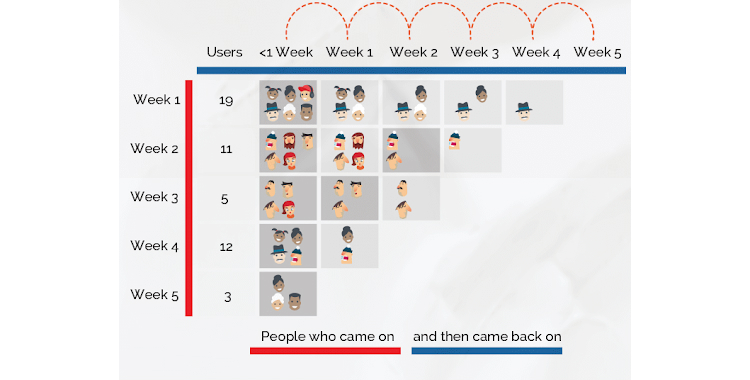One of the frequently asked question regarding the many Google analytics tools is what is cohort analysis. When used right, it can be a secret weapon to boost the performance of any business.

Google Analytics is considered a necessary staple for all digital marketers. It can single-handedly deliver data that can be further analyzed to optimize the business.
However, it is also necessary to know how to use this wealth of data to effectively promote business. In fact, Forbes conducted a study showing that doesn’t analyze data collected for marketing and sales miss out on 15 to 20% of marketing ROI. Thus, using all the information that Google analytics lays out for you, is useless without the correct methodologies.
When Google introduced the cohort analysis, it was not widely acknowledged as an efficient marketing tool. Even today, cohort analysis is one of the most underrated tools in marketing. But why is it so important. To answer that, it is necessary to understand what is cohort analysis.
Cohort Analysis

(source: blog.appsee.com)
Let us start by defining a “cohort” first. A cohort is considered as a set of people grouped based on a common value they share. Google takes it as a group of users that shares one or more characteristics identifiable as an analytical dimension. The concept is not confined to digital marketing alone, but in any field where the audience could be categorized.
What cohort analysis means in Google Analytics is the process of analyzing the different cohort groups and their behaviors. Cohort analysis could be used to understand the different patterns of audiences, the trends, and differences that could lead to different results.

Cohort analysis is not only beneficial to understand the audience, but it is also useful to know what marketing techniques work for which set of recipients. To study the impact of different marketing tactics, channels, content, and even web page designs, running a cohort analysis will provide insight on how the various approaches have been yielding and which aren’t.
Users can customize the Cohort type, size, matrics and dates to get specific results on particular campaigns.
How to Use Cohort Analysis for Keyword Research
Now that we have established what cohort analysis could be used for, it is time to look into how the tool can be put to better use for marketing research. There are indeed a few outcomes and approaches to experiment with.
Cohort analysis usually works in the retrospective of audience behavior. This is also one of the key methods to d keyword research specifically for the target audience. Consequently, any information you gather from the analysis is directly applicable to how the audience is responding to the marketing methods.
Here are a few ways to get the most of cohort analysis.
1. Explore all the Segments

(Source: humanlevel.com)
As mentioned before, this Google analytical tool comes with a few segments that are worth exploring. One can add more segments like mobile traffic, desktop users, etc. Moreover, you can also use the segments you have already identified as valuable to the website from Google analytics.
It is highly useful if you are looking to identify the sources of website traffic, to further focus on lead generation or to analyze the effect or a particular marketing technique.

2. Analyze Short Term Marketing
One of the most useful features of cohort analysis is to understand how a short term campaigning working out for the business. Whether you are aiming at creating trendy articles or email campaign, by selecting the time frame between the day they were published or send out, the tool gives out responses from the audience in the growth of the business.
This is very advantageous to understand how the structure of content marketing and the keywords associated are performing. It is not only crucial to identify the right keywords, but it is also important to place them organically in the text, even in emails. Without that, all the effort put into the research will not be yielding.

In many cases, it is worth to outsource articles from professionals who are experienced with crafting such articles. Affordable essay writing service like EssayPro has a longstanding record of offering expertise in the field of content writing. Though primarily a platform for educational writing services, they also focus on delivering quality articles that are well tailored to the demands of any particular business or marketing.
If resorting for marketing investment in these ways, users can now use “Traffic sources” as an additional segment in cohort analysis to know if it is a sales discount or an email campaign that has ticked off the traffic.
3. Understand the Habits of Audience
For any business, marketing today is focused on what marketers call the “pain points”. Whether it is in e-commerce or service, identifying what the audience is missing out is the key to establishing the marketing strategy. That is also what cohort analysis offers as its best feature.

Establishing categories of the audience and how they should be targeted is essential to work out any strategy to further expand the hold on the audience. For an e-commerce website, cohort analysis can be used to look at segments like transactions and revenue per user. The data provided can be in-depth on how much time the users spend on average to make on the transaction and so on.
Furthermore, as noted in the last point, identifying the sources for the sales will demonstrate what has caused a spike or drop in the revenue. The tool reports a remarkable insight into the purchasing behavior and what led to that, which consequently comes back to marketing strategies employed.
4. Persona-Driven Keyword Research
It all comes down to a circle; reports show the impact of marketing and it could be further used to identify keywords and it continues. But why is using cohort analysis better for keyword research?

Usually, digital marketers employ standard keyword classification. When you do that, there are always possibilities of ambiguity in keywords. So whatever planning or strategy might not yield the result you are hoping for. Informational and transactional keywords are not always to be accounted for consumer decisions.
So to understand what specifically the user is looking for, it is necessary to classify keyword research based on personas. As specific as it could be, the better the results are. The process commonly factors in audience surveys and search volume analysis to come up with the keyword portfolio.
Cohort analysis makes the process of audience surveys much easier by specifically displaying results of how each cohort is responding to the already existing marketing methods. It is one of the most efficient methods available to understand the relevance of audience behavior and employ it to the decision makings in crafting tactics.
Google analytics, as much as it offers an abundance of data, is also a little tricky to conclude from. The sheer volume of data alone makes it challenging to sort through the noise and identify the relevant metrics distinct to the business.
Cohort analysis is the answer to all these hindrances making the tool even more accessible to businesses. It reduces the time and effort required to sort through the data and use it adequately to improve the performance.
The benefits not only extend to keyword researches but also to monitor the impact of any marketing decision one employs in the website. The tool could do with a few upgrades and additional features, but as of now, it is the best approach available to offer insight to digital marketing.
About the Author
Michelle Brooks loves to read, write, listen to music and use words to persuade people. She has worked her way towards being the team leader of content managers. She uses words as weapons, so keep an eye out for her powerful articles. Visit her at Twitter.


